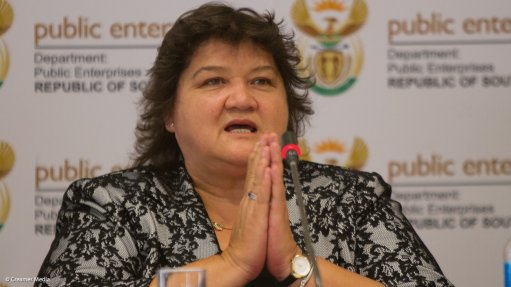
Public Enterprises Minister Lynne Brown
Photo by: Duane Daws
South Africa’s economic growth could be seriously hampered in the medium term if the country does not have additional electricity generation capacity. But, for now, government, as well as Eskom, is doing all it can to keep the lights on, says Public Enterprises Minister Lynne Brown.
“What we are trying to do is keep the lights on for what we have at the moment. It doesn’t help in areas of growth, but we have enough electricity for what we need on a daily basis,” she told an American Chamber of Commerce business breakfast in Cape Town.
Government was committed to maintenance, even if it led to load-shedding, said Brown, pointing out that Thursday marked the eighty-fifth day of no load-shedding.
“We will not stop maintenance. That’s the one issue I hold very, very dear. We must maintain plants that are old. We need 32 000 MW every day and we have to make sure we have 32 000 MW a day.”
Brown was concerned that the lack of additional capacity would lead to significant increases in electricity prices, if prices were determined by market forces.
“There’s been a push for increasing market influence into the electricity network, especially through privatisation. There’s also been a big call [to privatise State-owned power utility] Eskom.”
This, she said necessitated serious introspection into the demand and supply networks, and an ongoing assessment of the structure of Eskom.
“Electricity is a basic right. The structure of Eskom is transmission, generation and distribution . . . and the idea is to break the company into these three parts.
“I think basic services need to remain at the level of the State, so that the State can price it, but it doesn’t close off the public–private relations that can and do exist within Eskom.”
The Public Enterprises Minister noted that the private sector had a big role to play in energy generation.
The Renewable Energy Independent Power Producer Procurement Programme had been hailed for its success but, simultaneously, highlighted constraints on the alignment of the grid with renewable-energy sources.
Brown said in the areas optimal for wind and solar energy production, the grid was becoming increasingly constrained. Therefore, major investment was needed in transmission to enable the connection of renewable-energy plants in these areas. The same applied to conventional fossil-fuel-powered plants.
“In the case of the Waterberg, a major [high-voltage direct current] HVDC grid connection has been identified as a likely prerequisite for unlocking further large-scale power generation. The cost of such an HVDC scheme is estimated at R13-billion.”
Meanwhile, Brown added that South Africa supported the US energy initiative, Power Africa, as it focused US attention to the critical area of energy development.
However, she called for it to be extended to more countries in Africa and to take into consideration the continent’s energy agenda, which was articulated in the African Union’s Programme for Infrastructure Development in Africa.
The Minister highlighted that relations between South Africa and the US had been “very positive” during the administrations of President Jacob Zuma and President Barack Obama and had been strengthened by Obama’s official visit to South Africa in 2013.
The two-way trade between South Africa and the US increased from R56.7-billion in 2001 to more than R141-billion in 2014. Noteworthy was that bilateral trade recovered beyond the pre-crisis figure of R127-billion in 2008, which had declined to R83-billion in 2009.